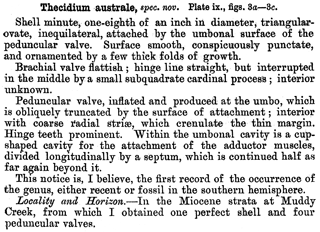 |
|
|||||||
Genus Lacazella Munier-Chalmas, 1880
|
| p. 279 [Type-species = Thecidea mediterranea Risso, 1826, p. 394] |
| Relatively small, irregular with convex pseudodeltidium; interior of ventral valve papillose to spinose except over muscle scars, hemispondylium projecting anteriorly as two spurs; dorsal valve with hypercline interarea, bridge with marsupial notch, median septum divided to form trifurcating structure consisting of pair of lateral ramuli and posterior median ridge uniting with jugal pillar, dorsal lobes interdigitat- ing with ramuli; shell granular except for superficial traces of fibrous secondary shell on dorsal surface of teeth; mantle thin, coarsely spicular. |
| Late Paleocene - Holocene
References: |
|
Species of Lacazella
|
|
|
Diagnosis Diagnosis Diagnosis Diagnosis Diagnosis |
|
|
|
Lacazella mediterranea (Risso, 1826) Type locality: off coast of Nice (France). Depth range: 1 - 110 m. Thecidea mediterranea Risso, 1826, p. 394
Diagnosis in facsimile - Risso (1826)
See Emig (2012) |
After Logan (1979) modified: Adult shell rarely exceeding 3 mm in length. Shell out!ine usually triangular, but may be irregular. Shell biconvex, dorsal valve almost flat, thin, circular to semi-circular in shape. Shell pale brown in colour, smooth or with irregular concentric growth lamellae, punctate. Hinge !ine straight. Anterior commissure rectimarginate to slightly unip!icate. Beak of ventral valve pointed, without foramen but with well defined attachment scar. Ventral cardinal area flat, triangular, with flat triangular pseudodeltidium. |
||
|
Lacazella australis (Tate, 1880) Type locality: "Superior beds" (Miocene: Balcombian), Muddy Creek, Victoria, Australia. Range: Early Miocene Thecidium australe Tate, 1880 p. 166 Diagnosis - Lee & Robinson (2003) Shape variable, subcircular in smaller specimens, elongate in larger specimens. Attachment scar well-developed, irregular in shape. Ventral valve with raised pseudodeltidium. Outer margins of ventral interarea poorly defined. Cardinal teeth robust. Hemispondylium well developed. No median septum. Cardinal process broad, projects strongly anteriorly. |
Diagnosis facsimile of Tate (1880)  |
||
|
Lacazella mauritiana Dall, 1920 Type locality: Mauritius Diagnosis - Dall (1921) This species has a remarquable resemblance to the preceding [= Lacazella mediterranea], with which it has been confounded, but differs by having in the apical cavity of the attached valve instead of a platform supported by a septum, only two long, slender, excavated, upturned pro cesses completely isolated medially, with no sign of a septum. The outer surface is minutely reguliarly granular. In other respects it agrees closely with L. mediterranea. |
|||
|
Lacazella caribbeanensis Cooper, 1977 Type locality: Station 52, east of Cabo Samaná, Dominican Republic in Cooper, 1977 p. 27 (not off Rio Bueno, north central Jamaica, as stated by Cooper, 1977, p. 133) Diagnosis - Cooper (1977) Small Lacazella with hemispondylium attached to the valve floor and the ascending apparatus narrow anteriorly and with smooth margins.
After Cooper (1977) >
|
Small, transversely oval in outline with the maximum width at about midvalve; sides somewhat narrowly rounded; anterior margin gently rounded to nearly straight; hinge narrower (about hall) than the valve width, beak somewhat narrowly pointed; pseudodeltidium (?) narrow, not strongly convex; shell substance punctate.
Ventral valve moderately convex and with a large area of attachment; anterior half somewhat flattened and moderately geniculated. Dorsal valve moderately swollen medially and with the sides and anterior somewhat tlattened. |
||
|
Lacazella novazelandiae Hiller, 2011 Type locality: Waitiiti Formation, Taita Stream, Waimamaku Valley, New Zealand. Range: Early Miocene Diagnosis - Hiller (2011) Small Lacazella with tiny teeth and subdued papillation in valve interiors. Dorsal interior with relatively narrow median septum with smooth margins.. |
Hiller (2011) pointed out: Unfortunately, Tate’s type material is presently unavailable for study so comparison with the New Zealand specimens is not possible. Therefore, as these represent the first record of the genus in New Zealand, they are regarded as a new species. |
||
